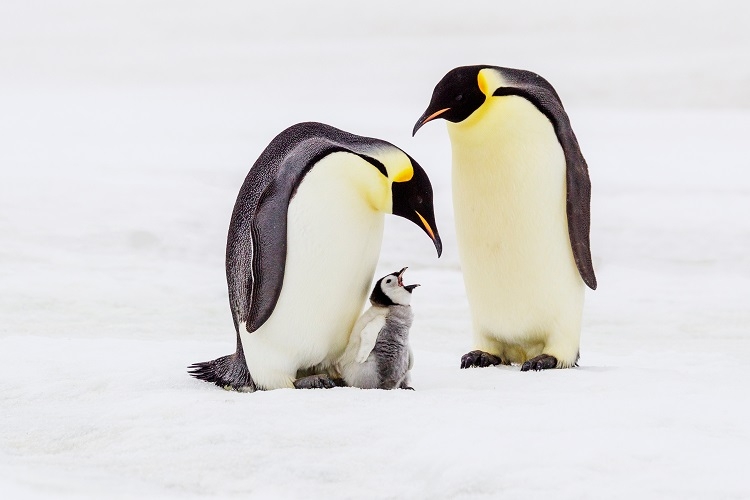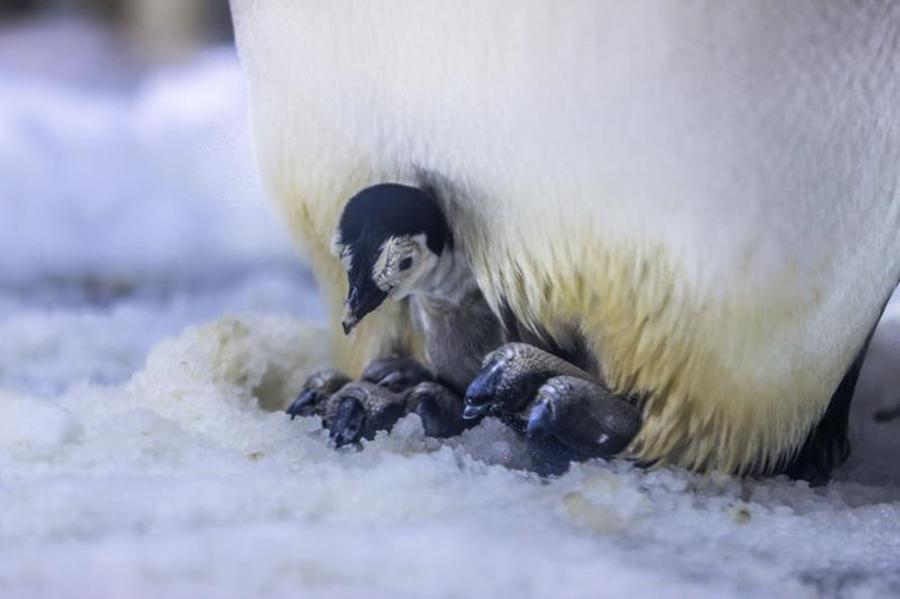The largest species of penguin and one of the largest birds in the world this week we’re focusing on the emperor penguin. Living exclusively in the freezing cold waters of the Antarctic this has put emperor penguins at direct risk of climate change.
Taxonomy and Evolution
Emperor penguins have the scientific name Aptenodytes forsteri sharing the genus with one other species, the second largest penguin in the world the king penguin. There was a third species that lived in New Zealand waters around 3 million years ago, commonly called Ridgen’s penguin. Living so far south Europeans may have actually been the first humans to spot emperor penguins with one of the figures on Captain Cook’s ship, Johann Reinhold Forster, in the mid-1770s but he initially thought they were large king penguins. For this reason the emperor penguin incorporates his surname into its scientific name. Emperor and king penguins, other than being the largest penguins, also represent one of the most basal branches of the penguin family. Fossil evidence has found that the ancestors to penguins evolved around 68 million years ago in Antarctica and New Zealand, and as this area became increasingly colder they adapted to a frozen world. However, the penguin family tree ended up branching out around 40 million years ago. Some remained in the Antarctic eventually evolving into the Aptenodytes genus while others moved north evolving into the other species of penguin.
Biology and Behaviour

As mentioned above, the emperor penguin is the largest species of penguin and the sixth largest species of living bird, only being exceeded by the giant ratites (ostriches, emus, rheas etc.). Males and females are generally the same size reaching just over a metre (4 feet) in height. Their weight can depend immensely by the time of year with males during the winter months losing up to 45% of their weight, but a healthy penguin before the breeding season have a range of 30 to 40 kilograms (66-88 pounds) with males being heavier. These birds have black back, wing, and head feathers with some flecks of white; a white front; and yellow patches around the jaw. Their chicks, meanwhile, have a silver-grey coat with a black head and a white mask. These penguins are also loud where each penguin has an individual call – something important when finding their partner and chick among the hundreds to thousands in a flock. Caws and whistles make up their calls.
Emperor penguins have evolved to live in a frozen world. The black feathers help absorb heat from the sun, something that can help them warm-up as they leave the freezing water and get onto the ice. A streamlined body helps them swim with agility in the water with their flippers being highly adapted wings, so emperor penguins effectively ‘fly’ through the water. While they ‘waddle’ clumsily on the land they are graceful in the water. Like many other animals living in frozen environments emperor penguins have a thick layer of fat called blubber to keep them warm, but this is not their only adaptation to keep the birds warm. Emperor penguins, and for that matter other penguins, have several layers of feathers that allow them to remain insulated. The topmost layers are waterproof which prevents the insulating feathers from getting wet which could cause the penguins to freeze. These several layers also trap air bubbles that are quickly released when the penguins move from deep to shallower water helping them leave the water at a faster rate. While diving their heart rates were 15% lower than while resting, reducing their metabolism and conserving energy. Upon leaving the water the penguins flap their wings to shake off the cold water. Also interesting, during the colder months they walk on their heels reducing contact with the ice and with it reducing the surface area from which heat is lost.
Reproduction

Emperor penguin chick rearing is one of the most intense experiences for a bird. Not only has it been depicted in several David Attenborough documentaries but it has also been depicted in an entire movie – March of the Penguins. Despite popular perception emperor penguins are not monogamous. They will have one partner during a breeding season and may return to one another in a future one, but a pair will only remain together for the one breeding season. The strong commitment to one another is an incredible bond. Pairs breed in March and April on the icy sheets a staggering 150km (95 miles) from the sea in certain breeding sites, approximately 61 across all of Antarctica. The female will lay an egg and in a delicate balancing act transfers it to the feet of the male who covers the egg with a flap of warm skin. If the egg is dropped then it is immediate game over – it will quickly freeze killing the embryo. The female then leaves to return to the sea to feed for the next two months. During these next couple months the males have to face the bitterest of cold, huddling together in their thousands to try and keep warm. Males cannot eat. Leaving their eggs will kill them so they have to rely on a fat reserve until the females return, however, the eggs hatch before the female return. Males will regurgitate a mixture of fats and proteins that, in theory, should keep the chicks going.

From May to June the chicks hatch and shortly after the females return. Some, sadly, do not. If the mother is killed the father may starve or abandon the chick. If lucky the chick might be adopted by another male who lost his egg or chick, although some fathers will try and kidnap chicks if he has lost his. The sharp beaks means this is a dangerous fight and chicks can be killed as the males fight. When the females return the males gently transfer the chicks to the feet of the females, again if dropped the bitter cold can kill the chick, before he goes to feed. The males will spend the next few weeks feeding and then the parents will take it in turn babysitting. During this period if one parent dies the other parent may eventually abandon the chick. Those lucky enough to not have this happen will develop enough feathers and fat, roughly 40 to 50 days, to leave the parents’ pouch where the chicks form a creche. Both parents will go feed until November. The chicks start moulting getting their new feathers just as the ice sheets start to break apart for the Antarctic summer. The parents then leave, their job done. Eventually the chicks will follow, hopefully their waterproof feathers had developed which will give them a fighting chance.
Diet and Predators

Emperor penguins are carnivores with their diet consisting of krill, fish, and squid. Their sharp beaks are good for capturing these animals, and they go to long lengths to hunt. Emperor penguins are capable of diving 564 metres (1,850 feet) down, deeper than any other bird can dive. The slowing down of their heart beat helps reduce pressure on their body going so deep with their blubber and feathers also trapping heat. Emperor penguins do have predators. Chicks are at risk from Southern giant petrels who have been known to literally steal chicks from the skin pouch and eat them before the parents’ eyes! It is difficult for penguins to fight back making it a brutal aspect of nature. Adult penguins do have predators, principally from leopard seals. Orcas do also eat penguins, sometimes even breaking up ice floats to get to penguins out of their reach.
Distribution and Habitat
Emperor penguins are one of two penguin species that live in Antarctica itself, the other being the king penguin. Being so far south it is also freezing. The coldest their habitat gets is -60 degrees Celsius (-76 degrees Fahrenheit) so you can see why a chick or egg being dropped by a parent will see it freeze so quickly. Emperor penguins also breed on sea ice, the ice formed when the sea freezes, as when it is time for their chicks to go their own way it is less of a distance for them to travel.
Conservation and Threats
In 2019 the IUCN evaluated the emperor penguin giving them a rating of ‘Near Threatened’ meaning they are not yet endangered, but soon will be. A 2014 paper even estimated that by 2052 the emperor penguin population would have halved, and since then conditions have worsened. Of course we are the issue. Global warming is shrinking the ice sheets that they nest on and are melting much earlier in the year so the next generation are forced into the water before their waterproof coat develops. Furthermore, climate change also shifts the sea currents that the animals that the penguins eat follow. As a result the penguins have a harder time finding food meaning they cannot feed the chicks. Unless if we act now to at least halt, never mind reverse, the damage we have done emperor penguins may vanish by the end of the century.
Bibliography:
- Peter Frances, (ed.), Bird: The Definitive Visual Guide, (London: DK, 2007)
- Peter Fretwell, Phil Trathan, Barbara Winecke, and Gerald Kooyman, ‘Emperor Penguins Breeding on Iceshelves’, PLoS One, 9:1, (2014)
- Christophe Barbraud and Henri Weimerskirch, ‘Emperor penguins and climate change’, Nature, 411:6834, (2001), 183-186
- Allan Baker, Sergio Luiz Pereira, Oliver Haddrath, and Kerri-Anne Edge, ‘Multiple gene evidence for expansion of extant penguins out of Antarctica due to global cooling’, Proc Biol Sci, 273:1582, (2006), 11-17
- Jonathan Amos, ‘Climate Change: Satellites find new colonies of Emperor Penguins’, BBC News, (05/08/2020), [Accessed 18/05/2024]
- Gerald L. Kooyman, Paul J. Ponganis, Michael A. Castellini, Edward P. Ponganis, Katherine V. Ponganis, Philip H. Thorson, Scott A. Eckert, and Yvon Lemaho, ‘Heart Rates and Swim Speeds of Emperor Penguins Diving Under Sea Ice’, The Journal of Experimental Biology, 165:1, (1992), 161-180
- BirdLife International, ‘Aptenodytes fosteri‘, IUCN Red List, (28/08/2019), [Accessed 19/05/2024]
- Janet Mohun and Peter Frances, (eds.), Wildlife of the World, (London: DK, 2015)
